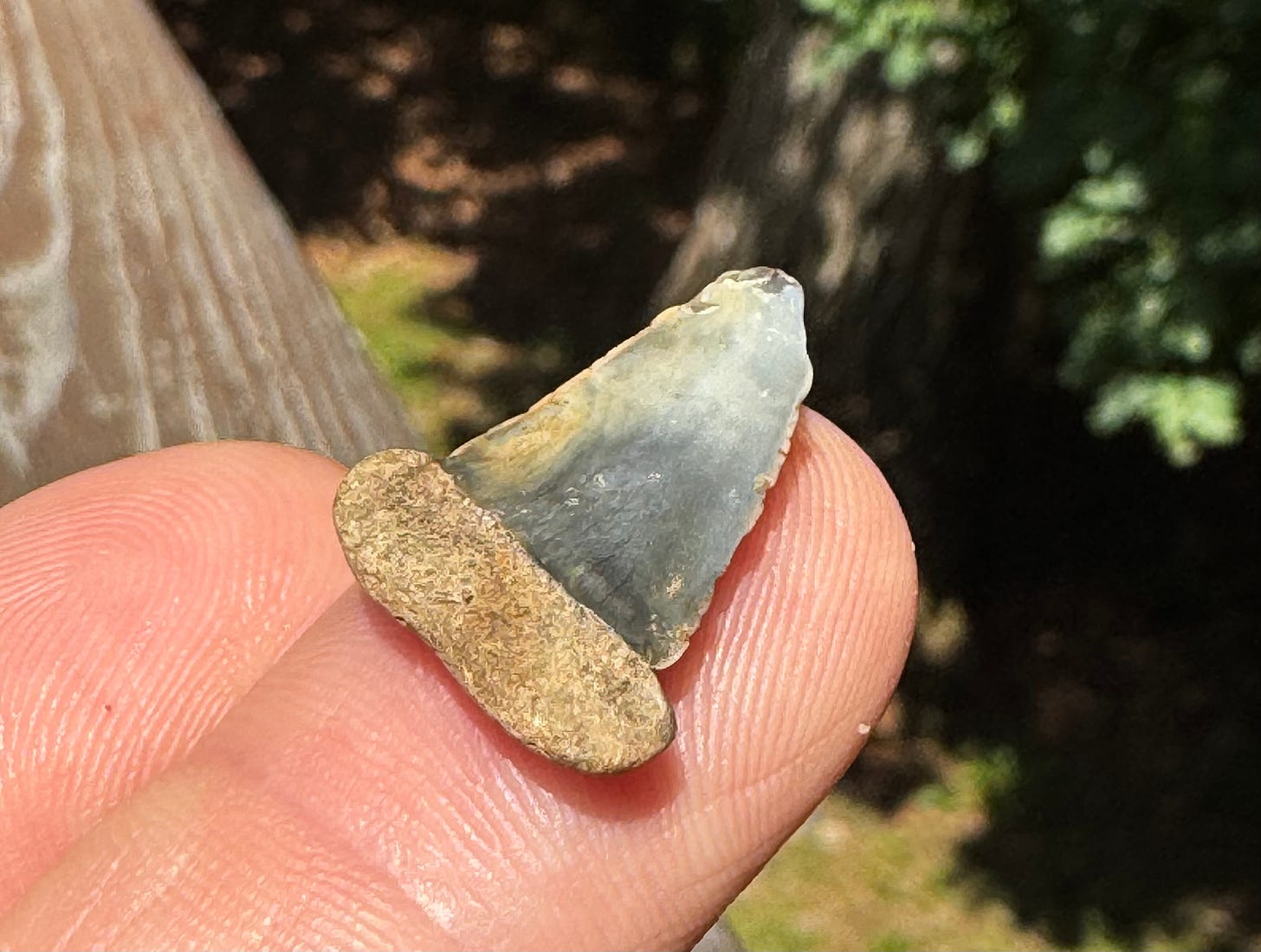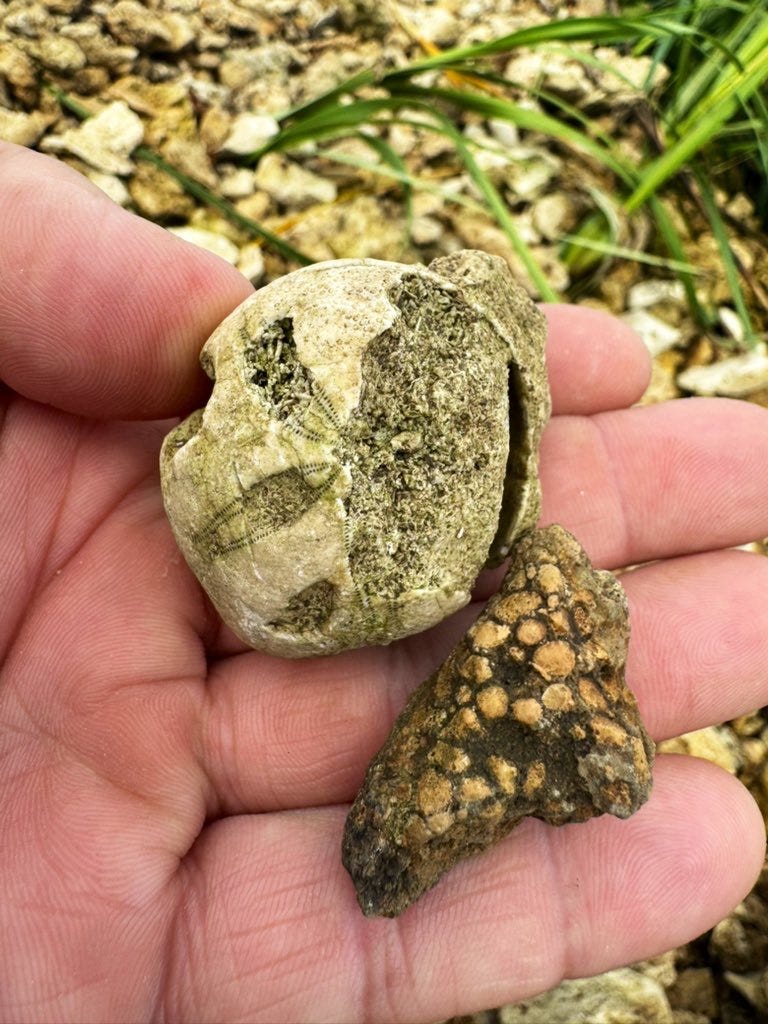Last weekend, my partner Sarah and I explored the mouth of the Cape Fear River, where the creek from our backyard meets the Atlantic.
We paddled upstream to a series of spoil-islands, piles of gravel the US Army Corp had dredged from the river-bottom so ships could reach the port upstream.
A pair of disappointed anhingas screeched as we landed on their sandbar, disturbing their hunt on the incoming tide.
We’d missed the low, waiting out thunderstorms under a picnic shelter. So we had to pick through the rocks quickly as flood-tide swallowed the shoreline.
With the paddleboards nearly floating away, Sarah found this large fossilized tooth, a smoky-gray enamel point with a serrated edge.
We’d found other fossils - smaller teeth, a nautilid called an Aturia, some seabiscuits, but nothing as impressive as the inch-long Carcharocles angustidens tooth. It had fallen from the mouth of a juvenile around 35 million years ago when the Carolina Coast was a prehistoric shark nursery.
Paleontologists say C. angustidens adults grew to nearly fort-feet long. For comparison, the world’s largest radio-tagged Great White (who pinged a transmitter just off the North Carolina shore the week before) measured a mere 14-feet.
Sarah and I had been thinking about sharks since last summer, when we’d been fishing a tidewater marsh near Beaufort SC. A four-foot shark had snatched a sea-trout I’d left dangling half in the water. I’d felt the shark thrashing against the bottom of the paddleboard through the soles of my feet.
There was no hesitation in snatching that fish from a larger, dangerous animal, and no warning. If you watch sharks, they’re not keyed up all the time - in fact, they seem preternaturally calm and deliberate when they’re not feeding. But there’s something unknowable about them.
People describe insects or snakes as emotionless, but that’s not my experience. I can usually read an aspect of pretty much any animal, even other fish, by eye contact.
Sarah is reading How Forests Think and Eduardo Kohn opens with a story about the local people telling him to wear a mask on the back of his head, so the jaguars would not sneak up behind him and mistake him for prey. The eye contact, albeit faked in this case, confirms you are not food but rather an annoying neighbor.
I’m not sure you can make eye contact with a shark in a way that conveys our shared inner experience. Sharks pre-date every land animal in the fossil record. They existed before trees, before insects.
While poring through our fossils trying to make IDs, Sarah and I had wondered if shark consciousness was one of the earliest forms of thinking. Did they process information differently from other creatures?
What if sharks once had a conscious experience more like our own, more reflexive and self aware - and tens of millions of years of evolutionary time had pared that reflective aspect down to nothing?
Something in the shark’s unknowableness reminded us of the disruptive non-linearity we associate with communication from whatever entities we call faeries, UFOs, angels, ancestral ghosts, etc.
Sarah brought up the description of the aliens (or angels?) from WAWI (What Are We Inside). One of my favorite podcasters and researchers, Kelly Chase said this about WAWI’s book:
I've been breathlessly tearing through this expanded edition of Terrible, Glorious, & Useful that just dropped. This isn't just my favorite book in this field—I think it's just my favorite book. Simply stunning.
Terrible, Glorious and Useful is a book length poem/semi-channeled conversation between a human and an alien intelligence. So much of the book is transcendent, but this part was so bonkers I found myself incredulously reading this aloud to Sarah again.
Trevor Shikaze, describing the angelic or alien being he was communing with:
“It had many rows of pointed teeth, a mouth like a fleshy sinkhole, the flattened face of a stingray, and black, inky, inhuman eyes.”
Sarah and I sat with the idea of sharks representing ancestors or something stranger.
What can be communicated across an ocean of time, tens of millions of years wide?
At high tide, the Cape Fear River is a half-mile across at Shark Tooth Island. The scale of it helps me think about deep time and imagine the river in a new way.
We’ve been listening to Robert McFarlane’s new work, Is a River Alive?
McFarlane was describing the Strahler-Horton Stream Order system, a method hydrologists use to categorize stream complexity by counting the number and dependencies of the branching tributaries feeding the mainstem.
In this system, you imagine the mouth of the river as the roots of a huge tree. The limbs spiral upstream, with tributaries branching across the land like reaching treetops.
When I imagined the Haw River that way, I thought about the trees and the water cycle circulating within the river system, the forest and the river breathing with the Atlantic.
Looking at it this way, I could see our river as a “World Tree”.
So here at the mouth of the Cape Fear, we were at the watery roots of our world tree, traversing the underworld where the past is held.
Finding fossilized shark teeth felt like an extension of our experience finding arrowheads on the gravel bars on Little Alamance Creek in our forest.
I’d adjusted my worldview to the idea that 10,000 years wasn’t that long ago. That I could pick up a rock and feel the human intent in a blade or a spearpoint from the first humans who’d lived in my woods.
That experience felt like a demonstration of continuousness, a coherence of place and personhood persisting through time.
The fossilized teeth spoke to something different - that there is a persistence of a being over such massive periods of time that the world itself is unrecognizable.
It’s a great lesson for what comes next.
I’ll describe it in the next newsletter. Thanks for reading.





